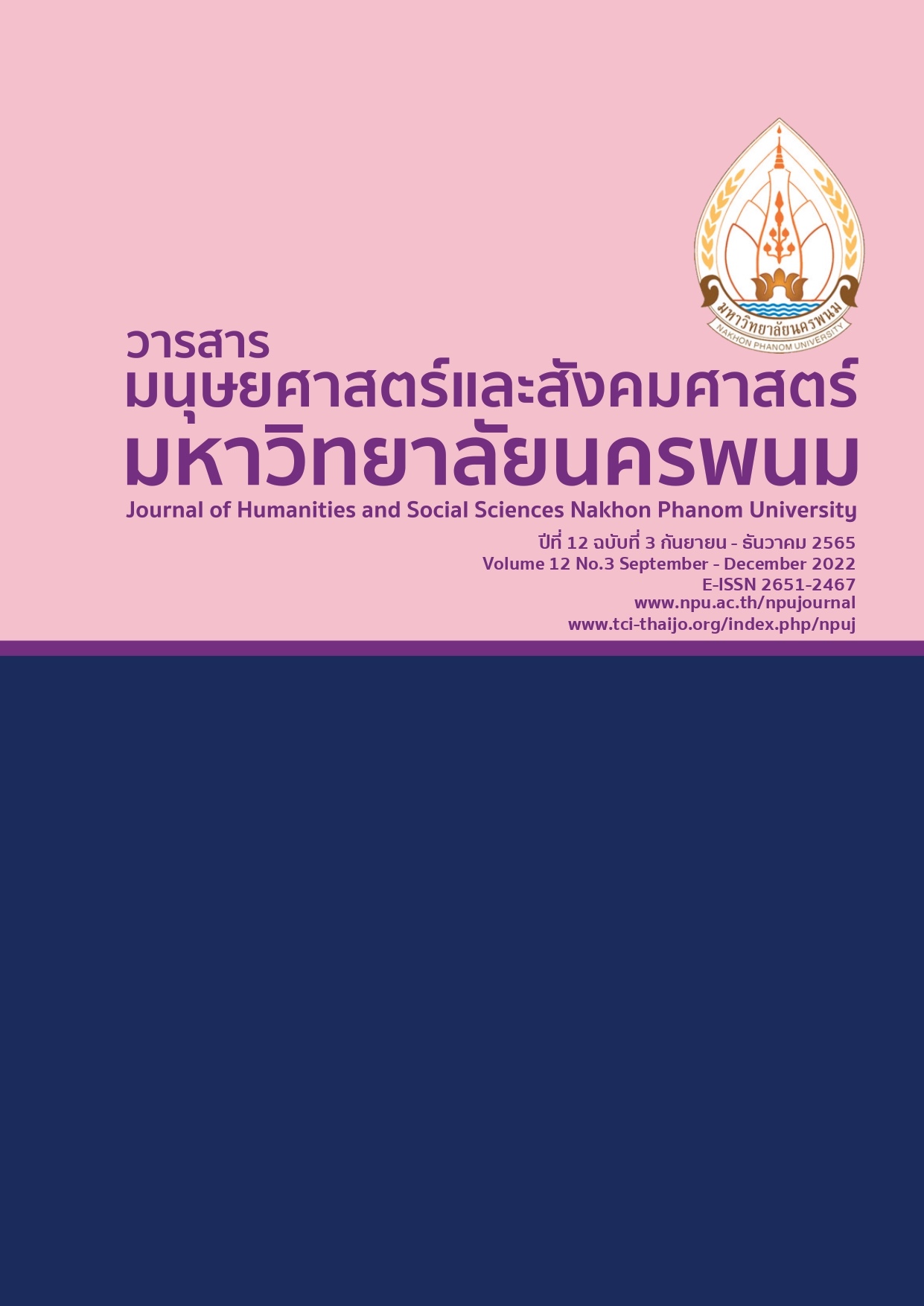แนวทางการสร้างความได้เปรียบในการแข่งขันของผู้ประกอบการตลาดประชารัฐต้องชม
Main Article Content
บทคัดย่อ
การวิจัยครั้งนี้มีวัตถุประสงค์เพื่อศึกษาความสำคัญของคุณลักษณะผู้นำ ทรัพยากรพื้นฐาน การมีส่วนร่วม มูลค่าเพิ่มผลิตภัณฑ์ และความได้เปรียบในการแข่งขันของผู้ประกอบการตลาดประชารัฐต้องชม เพื่อตรวจสอบความสอดคล้องตามตัวแบบสมการโครงสร้าง การสร้างความได้เปรียบในการแข่งขัน ของผู้ประกอบการตลาดประชารัฐต้องชม และเพื่อนำเสนอ แนวทางการสร้างความได้เปรียบในการแข่งขันของผู้ประกอบการตลาดประชารัฐต้องชม เป็นการวิจัยแบบผสมผสานกลุ่มตัวอย่าง คือ ผู้ประกอบการตลาดประชารัฐต้องชม เขตภาคเหนือตอนบน 1 จำนวน 330 คน สุ่มตัวอย่างแบบอย่างง่าย เครื่องมือวิจัยคือแบบสอบถาม วิเคราะห์ข้อมูลด้วยสถิติวิเคราะห์โมเดลสมการโครงสร้าง ส่วนการวิจัยเชิงคุณภาพใช้การสนทนากลุ่มกับกลุ่มเป้าหมาย 12 คน สุ่มตัวอย่างแบบเจาะจง ผลการวิจัยพบว่า กลุ่มตัวอย่างให้ความสำคัญต่อคุณลักษณะผู้นำเป็นอันดับแรก รองลงมาคือมูลค่าเพิ่มผลิตภัณฑ์ ความได้เปรียบในการแข่งขัน การมีส่วนร่วม และทรัพยากรพื้นฐานโดยทุกปัจจัยอยู่ในระดับมากที่สุด ตัวแบบสมการโครงสร้าง มีความสอดคล้องกับข้อมูลเชิงประจักษ์ (χ2 = 107.816, df = 86, χ2/df = 1.254, GFI = .956, CFI = .995, RMSEA = .030, RMR= .007) โดยพบว่า คุณลักษณะผู้นำมีอิทธิพลทางตรง[i]ต่อการมีส่วนร่วมมากที่สุด รองลงมาทรัพยากรพื้นฐานมีอิทธิพลทางตรงต่อความได้เปรียบในการแข่งขัน คุณลักษณะผู้นำมีอิทธิพลทางตรงต่อทรัพยากรพื้นฐาน ทรัพยากรพื้นฐานมีอิทธิพลทางตรงต่อมูลค่าเพิ่มผลิตภัณฑ์ การมีส่วนร่วมมีอิทธิพลทางตรงต่อทรัพยากรพื้นฐาน คุณลักษณะผู้นำมีอิทธิพลทางตรงต่อมูลค่าเพิ่มผลิตภัณฑ์ มีนัยสำคัญทางระดับสถิติ .05 ตามลำดับ ได้แนวทางการสร้างความได้เปรียบในการแข่งขันดังนี้ คือ 1) มีกระบวนการคัดเลือกและพัฒนาเพื่อให้ได้มาซึ่งผู้นำ ที่มีคุณลักษณะที่ดี 2) สนับสนุนส่งเสริมการมีส่วนร่วมของผู้มีส่วนได้เสีย 3) มีการบริหารจัดการทรัพยากรพื้นฐานอย่างมีประสิทธิภาพ และ 4) ส่งเสริมการผลิตสินค้าที่มีอัตลักษณ์ชุมชน
Article Details

This work is licensed under a Creative Commons Attribution-NonCommercial-NoDerivatives 4.0 International License.
References
Boonyarasai, P., & Jongsureyaphas, C. (2018). Patčhai khwāmsamret khō̜ng phalittaphan nưng phalittaphan nưng tambon khō̜ng Thai [Key Success Factors of Thai OTOP].Journal of Management Science Chiangrai Rajabhat University, 13(2), 37-60. [in Thai]
Boromsamlee, K., & Sunson, R. (2017). Rūpbǣp konlayut kāntalāt phư̄a kānthō̜ngthīeo talātnam bǣp yangyư̄n [The Marketing Strategy Model for Sustainable Floating Market Tourism]. Veridian E-Journal, Silpakorn University (Humanities, Social Sciences and arts), 10(2), 1-22. [in Thai]
Cohen, John M. and Uphoff, Norman T. (1980). Participation’s Place in Rural Development: Seeking Clarity Through Specificity World Development. Vol 8.
Hair, J., Black, W., Babin, B., Anderson, R. & Tatham, R. (2006). Multivariate data analysis (6th ed.). Uppersaddle River, N.J. : Pearson Prentice Hall.
Harzing, A. W., & Giroud, A. (2014). The competitive advantage of nations: An application to academia. Journal of Informetrics, 8(1), 29-42.
Isranews. (2018). Khamūat pom rō̜n sāraphat panhā talāt prachā rat (rāng) non bot sathō̜n rop . biktū kǣ thutčharit radap rāk yā ? [Tie a hot knot, all kinds of problems, Pracharat market (abandoned) Non Reflection of the Battle of Big Tu Solve grassroots corruption?]. Retrieved February 19, 2019, from https://www.isranews. org/isranews-scoop/66113-report04-66113.html. [in Thai]
Kaglai, K., & Pungnirund, B. (2017). Itthiphon khō̜ng phāwa phū nam kānmī sūanrūam rǣng čhūngčhai læ nawattakam kānsưksā thī mī tō̜ khwāmsamret kānbō̜rihān khō̜ng khana kammakān sathān sưksākhan phư̄nthān nai čhangwat Phuket [The Influences of Leadership Participation Motivation and Educational Innovation on Successful Management of Basic Education School Board in Phuket Province]. Journal of the Association of Researchers, 22(2), 21-36. [in Thai]
Linjee, C. (2020). Konlayut kānsāng khwām daiprīap thāngkān khǣngkhan khō̜ng samnakngān banchī nai prathēt Thai [The Competitive Advantage Strategy of Accounting Firms in Thailand]. The journal of Development Administration Research, 10(1), 128-137. [in Thai]
National Economic and Social Development Board. (2017). Phǣn phatthanā sētthakit læ sangkhom hǣng chāt chabap thī sipsō̜ng (Phō̜.Sō̜. 2560 - 2564) [12th National Economic and Social Development Plan (2017 - 2021)]. Prime Minister's Office. Bangkok. [in Thai]
Nunnally, J. C., & Bernstein, I. H. (1994). Psychometric theory (3 rd ed.). New York: McGraw-Hill.
Office of the Permanent Secretary for Interior. (2017). Khūmư̄ kāndamnœ̄n khrōngkān talāt prachā rat [Manual of Pracharat Market Project]. Retrieved May 18, 2020, from http://www.market. moi.go.th/download/manaul.pdf. [in Thai]
Pocmontri, A., & Somjai, S. (2018). Kān phœ̄m mūnlakhā kānphatthanā khīt khwāmsāmāt læ patčhai ʻư̄n ʻư̄n thī song phon tō̜ kāntalāt yāng yangyư̄n khō̜ng sinkhā phrīmīamʻōthō̜p čhāk phaktopchawā [Value Added, Competitive Development, Product Development and Philosophy of Sufficiency Economy for Sustainable Marketing of Premium OTOP Hyacinth]. Academic Journal Bangkokthonburi University, 7(2), 68-80. [in Thai]
Porter, M. E. (1985). Competitive advantage creating and sustained superior performance. New York:
The Free Press.
Porter, M. E. (2011). Competitive advantage of nations: creating and sustaining superior performance. Simon and Schuster.
Sakhonkaruhatdej, K., Khorchuklang, S., & Changkaew, L. (2017). Mōdēn khwāmsamphan chœ̄ng khrōngsāng khō̜ng khwāmsāmāt chœ̄ng phonlawat khwām dai prīap thāngkān khǣngkhan læ khwāmsamret khō̜ng thurakit nai ʻutsāhakam ʻāhān prǣrūp khō̜ng prathēt Thai [Structural Relation Model of Dynamic Capabilities, Competitive Advantage and Business Success of Food Processing Industry in Thailand]. Journal of Business, Economics and Communications, 12(1), 32-44. [in Thai]
Sangsod, S., & Suwan, M. (2020). Konlayut nai kānsāng khwāmkhēmkhæng hai kǣ chumchonphāk nư̄a tō̜n bon dōi chai sētthakit chumchon pen thān [Strategy for Strengthening Northern Communities,Using Community Economy Based]. School of Administrative Studies Academic Journal, 3(2), 40-56. [in Thai]
Smathanares, B., Rattakorn, A., & Wana, C. (2018). Konlayut kānčhatkān thī yangyư̄n khō̜ng thurakit khanāt klāng praphēt rōngrǣm thī phak nai Krung Thēp Mahā Nakhō̜n [Strategic for Sustainable Management of Medium Enterprises for Hotel Industry, Bangkok]. Srinakharinwirot Business Journal, 9(1), 41-53. [in Thai]
Smith, J. Brock., & Colgate, Mark. (2007). Customer value creation: A practical framework. Journal of Marketing Theory and Practice, 15(1), 7-23.
Somsri, C., Hongsam, B., & Netpradit, N. (2017). Itthiphon khō̜ng konlayut thurakit nawattakam kānmī sūanrūam kān mungnēn kāntalāt thī mī tō̜ khwām daiprīap nai kān khǣngkhan khō̜ng wisāhakitchumchon čhangwat lampāng [Business Strategic Influence, Innovation, Participation and Market Orientation toward Competitive Advantage of Community Enterprise in Lampang Province]. FEU Academic Review, 11(3), 161-173. [in Thai]
Thammawimutti, A., & Chuntuk, T. (2017). Thun manut chœ̄ng nawattakam læ sāngsan khō̜ng phū prakō̜p kān wisāhakit chumchon [Innovative and Creative Human Capital of Community Enterprise Entrepreneurs]. Veridian E-Journal, Silpakorn University (Humanities, Social Sciences and arts), 10(1), 1572-1589. [in Thai]
Wingwon, B., Jaikaew, A., Meksuwan, A., & Khamngern, P. (2017). Kānsāng mūnlakhā phœ̄m phalittaphan dūai phūmpanyā thō̜ngthin khō̜ng klum phūsūngʻāyu tambon wīang ʻamphœ̄ chīang sǣn čhangwat chīang rāi [Value-Added On Local Wisdom Products Of Elderly Group In Tumbol Wieang, Chiang Saen District, Chiang Rai Province]. 5th National Academic Conference (pp. 233-242). Ubon Ratchathani Rajabhat University: Faculty of business administration and management. [in Thai]
Yukl, Gary A. (1998). Leadership in organizations. (4th ed.). Englewood Cliffs. NJ: Prentice Hall Anker.

